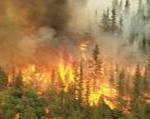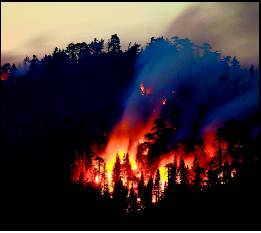FOREST FIRE
 
The most common hazard in forests is forests fire. Forests fires are as old as the forests themselves. They pose a threat not only to the forest wealth but also to the entire regime to fauna and flora seriously disturbing the bio-diversity and the ecology and environment of a region. During summer, when there is no rain for months, the forests become littered with dry senescent leaves and twinges, which could burst into flames ignited by the slightest spark. The Himalayan forests, particularly, Garhwal Himalayas have been burning regularly during the last few summers, with colossal loss of vegetation cover of that region.
Forest fire causes imbalances in nature and endangers biodiversity by reducing faunal and floral wealth. Traditional methods of fire prevention are not proving effective and it is now essential to raise public awareness on the matter, particularly among those people who live close to or in forested areas.
CAUSES OF FOREST FIRE
Forest fires are caused by Natural causes as well as Man made causes
- Natural causes- Many forest fires start from natural causes such as lightning which set trees on fire. However, rain extinguishes such fires without causing much damage. High atmospheric temperatures and dryness (low humidity) offer favorable circumstance for a fire to start.
- Man made causes- Fire is caused when a source of fire like naked flame, cigarette or bidi, electric spark or any source of ignition comes into contact with inflammable material.
Traditionally Indian forests have been affected by fires. Themenace has been aggravated with rising human and cattle population and the consequent increase in demand for Forest products by individuals and communities. Causes of forest fires can be divided into two broad categories: environmental (which are beyond control) and human related (which are controllable).
Environmental causesare largely related to climatic conditions such as temperature, wind speed and direction, level of moisture in soil and atmosphere and duration of dry spells. Other natural causes are the friction of bamboos swaying due to high wind velocity and rolling stones that result in sparks setting off fires in highly inflammable leaf
litter on the forest floor.
Human related causesresult from human activity as well as methods of forest management. These can be intentional or unintentional, for example:
- graziers and gatherers of various forest products starting small fires to obtain good grazing grass as well as to facilitate gathering of minor forest produce like flowers of Madhuca indica and leaves of Diospyros melanoxylon
- the centuries old practice of shifting cultivation (especially in the North-Eastern region of India and inparts of the States of Orissa and Andhra Pradesh).
- the use of fires by villagers to ward off wild animals
- fires lit intentionally by people living around forests for recreation
- fires started accidentally by careless visitors to forests who discard cigarette butts.
The causes of forest fire have been increasing rapidly. The problem has been accentuated by the growing human and cattle population. People enter forests ever more frequently
to graze cattle, collect fuelwood, timber and other minorforest produce. It has been estimated that 90% of forest fires in India are man-made
Classification of Forest Fire
Forest fire can broadly be classified into three categories;
- Natural or controlled forest fire.
- Forest fires caused by heat generated in the litter and other biomes in summer through carelessness of people (human neglect) and
- Forest fires purposely caused by local inhabitants.
Types of Forest Fire
There are two types of forest fire i) Surface Fire and ii) Crown Fire
Surface Fire-
A forest fire may burn primarily as a surface fire, spreading along the ground as the surface litter (senescent leaves and twigs and dry grasses etc) on the forest floor and is engulfed by the spreading flames.
Crown Fire-
The other type of forest fire is a crown fire in which the crown of trees and shrubs burn, often sustained by a surface fire. A crown fire is particularly very dangerous in a coniferous forest because resinous material given off burning logs burn furiously. On hill slopes, if the fire starts downhill, it spreads up fast as heated air adjacent to a slope tends to flow up the slope spreading flames along with it. If the fire starts uphill, there is less likelihood of it spreading downwards.

EFFECT OF FOREST FIRE
Fires are a major cause of forest degradation and have wide ranging adverse ecological, economic and social impacts, including:
- loss of valuable timber resources
- degradation of catchment areas
- loss of biodiversity and extinction of plants and animals
- loss of wildlife habitat and depletion of wildlife
- loss of natural regeneration and reduction in forest cover
- global warming
- loss of carbon sink resource and increase in percentage of CO2 in atmosphere
- change in the microclimate of the area with unhealthy living conditions
- soil erosion affecting productivity of soils and production
- ozone layer depletion
- health problems leading to diseases
- loss of livelihood for tribal people and the rural poor, as approximately 300 million people are directly dependent upon collection of non-timber forest products from forest areas for their livelihood.
The needs of the fire management
The incidence of forest fires in the country is on the increase and more area is burned each year. The major cause of this failure is the piecemeal approach to the problem. Both the national focus and the technical resources required for sustaining a systematic forest fire management programme are lacking in the country. Important forest fire management elements like strategic fire centres, coordination among Ministries, funding, human resource development, fire research, fire management, and extension programmes are missing.
Taking into consideration the serious nature of the problem, it is necessary to make some major improvements in the forest fire management strategy for the country. The Ministry of Environment and Forests, Government of India, has prepared a National Master Plan for Forest Fire Control. This plan proposes to introduce a well-coordinated and integrated fire-management programme that includes the following components:
- Prevention of human-caused fires through education and environmental modification. It will include silvicultural activities, engineering works, people participation, and education and enforcement. It is proposed that more emphasis be given to people participation through Joint Forest Fire Management for fire prevention.
- Prompt detection of fires through a well coordinated network of observation points, efficient ground patrolling, and communication networks. Remote sensing technology is to be given due importance in fire detection. For successful fire management and administration, a National Fire Danger Rating System (NFDRS) and Fire Forecasting System are to be developed in the country.
- Fast initial attack measures.
- Vigorous follow up action.
- Introducing a forest fuel modification system at strategic points.
- Firefighting resources.
Each of the above components plays an important role in the success of the entire system of fire management. Special emphasis is to be given to research, training, and development
Integrated forest protection
The main objective of this scheme to control forest fires and strengthen the forest protection in Tamilnadu. The works like fireline clearing, assistance to Joint Forest Management committees, creating water bodies, purchase of vehicles and communication equipments, purchase of fire fighting tools, etc., are being undertaken.
Source:
www.thehindu.com/2006/02/04/stories/2006020416080100.htm
www.library.thinkquest.org
www.fao.org/forestry/
Daily forest alert: www.nrsa.gov.in/rsgisweb/forestfires/dailyforestfires.html
List of fire station: www.tnfrs.tn.nic.in//stns.htm
Links
http://www.tnfrs.tn.nic.in//default.htm
|



